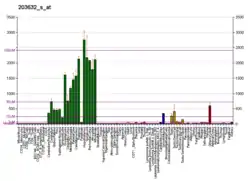GPRC5B
G-protein coupled receptor family C group 5 member B is a protein that in humans is encoded by the GPRC5B gene.[5][6][7]
Function
The protein encoded by this gene is a member of the type 3 G protein-coupled receptor family. Members of this superfamily are characterized by a signature 7-transmembrane domain motif. The specific function of this protein is unknown; however, this protein may mediate the cellular effects of retinoic acid on the G protein signal transduction cascade.[7]
References
- GRCh38: Ensembl release 89: ENSG00000167191 - Ensembl, May 2017
- GRCm38: Ensembl release 89: ENSMUSG00000008734 - Ensembl, May 2017
- "Human PubMed Reference:". National Center for Biotechnology Information, U.S. National Library of Medicine.
- "Mouse PubMed Reference:". National Center for Biotechnology Information, U.S. National Library of Medicine.
- Loftus BJ, Kim UJ, Sneddon VP, Kalush F, Brandon R, Fuhrmann J, Mason T, Crosby ML, Barnstead M, Cronin L, Deslattes Mays A, Cao Y, Xu RX, Kang HL, Mitchell S, Eichler EE, Harris PC, Venter JC, Adams MD (Nov 1999). "Genome duplications and other features in 12 Mb of DNA sequence from human chromosome 16p and 16q". Genomics. 60 (3): 295–308. doi:10.1006/geno.1999.5927. PMID 10493829.
- Bräuner-Osborne H, Krogsgaard-Larsen P (Jul 2000). "Sequence and expression pattern of a novel human orphan G-protein-coupled receptor, GPRC5B, a family C receptor with a short amino-terminal domain". Genomics. 65 (2): 121–8. doi:10.1006/geno.2000.6164. PMID 10783259.
- "Entrez Gene: GPRC5B G protein-coupled receptor, family C, group 5, member B".
Further reading
- Robbins MJ, Michalovich D, Hill J, Calver AR, Medhurst AD, Gloger I, Sims M, Middlemiss DN, Pangalos MN (2001). "Molecular cloning and characterization of two novel retinoic acid-inducible orphan G-protein-coupled receptors (GPRC5B and GPRC5C)". Genomics. 67 (1): 8–18. doi:10.1006/geno.2000.6226. PMID 10945465.
External links
- "GPRC5 Receptors: RAIG2". IUPHAR Database of Receptors and Ion Channels. International Union of Basic and Clinical Pharmacology.
This article incorporates text from the United States National Library of Medicine, which is in the public domain.
This article is issued from Wikipedia. The text is licensed under Creative Commons - Attribution - Sharealike. Additional terms may apply for the media files.





